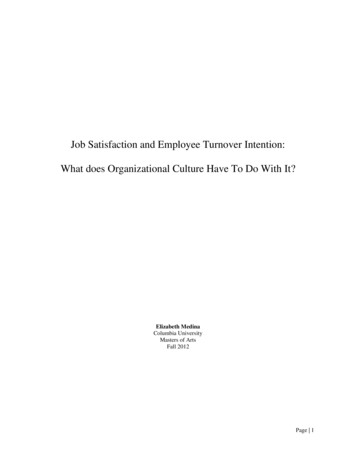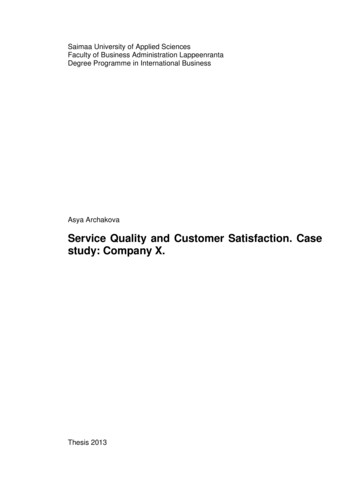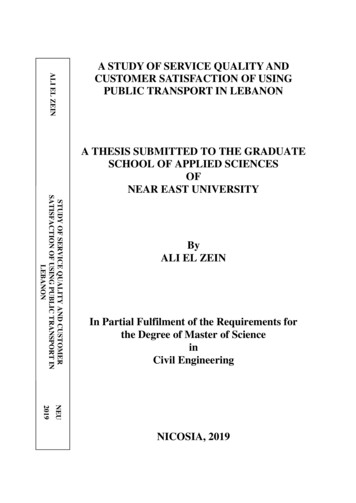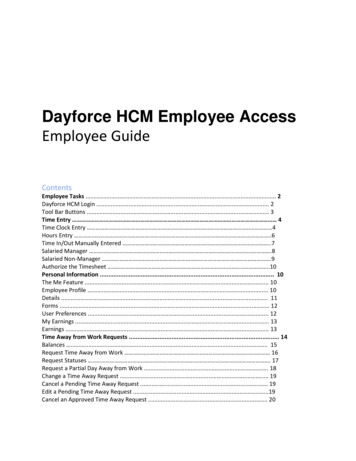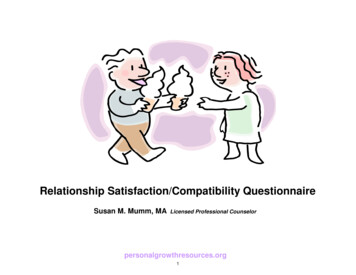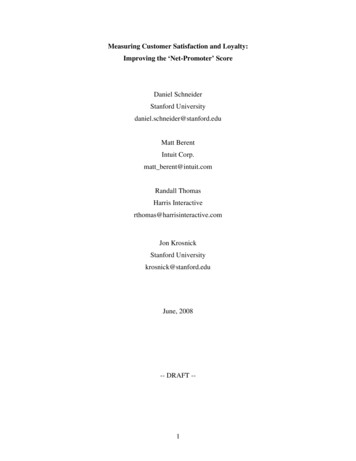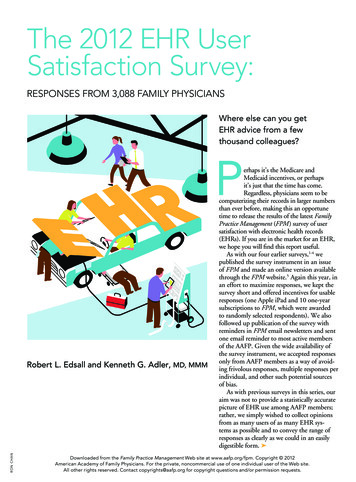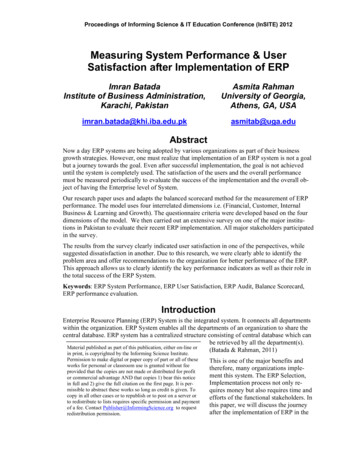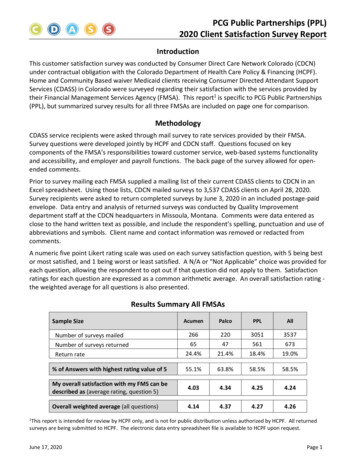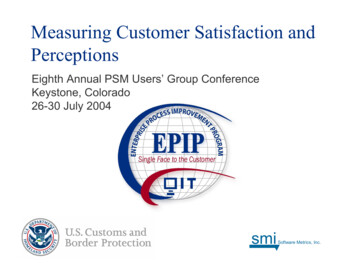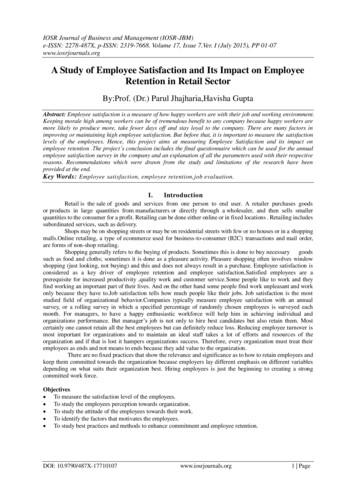
Transcription
IOSR Journal of Business and Management (IOSR-JBM)e-ISSN: 2278-487X, p-ISSN: 2319-7668. Volume 17, Issue 7.Ver. I (July 2015), PP 01-07www.iosrjournals.orgA Study of Employee Satisfaction and Its Impact on EmployeeRetention in Retail SectorBy:Prof. (Dr.) Parul Jhajharia,Havisha GuptaAbstract: Employee satisfaction is a measure of how happy workers are with their job and working environment.Keeping morale high among workers can be of tremendous benefit to any company because happy workers aremore likely to produce more, take fewer days off and stay loyal to the company. There are many factors inimproving or maintaining high employee satisfaction. But before that, it is important to measure the satisfactionlevels of the employees. Hence, this project aims at measuring Employee Satisfaction and its impact onemployee retention .The project’s conclusion includes the final questionnaire which can be used for the annualemployee satisfaction survey in the company and an explanation of all the parameters used with their respectivereasons. Recommendations which were drawn from the study and limitations of the research have beenprovided at the end.Key Words: Employee satisfaction, employee retention,job evaluation.I.IntroductionRetail is the sale of goods and services from one person to end user. A retailer purchases goodsor products in large quantities from manufacturers or directly through a wholesaler, and then sells smallerquantities to the consumer for a profit. Retailing can be done either online or in fixed locations . Retailing includessubordinated services, such as delivery.Shops may be on shopping streets or may be on residential streets with few or no houses or in a shoppingmalls.Online retailing, a type of ecommerce used for business-to-consumer (B2C) transactions and mail order,are forms of non-shop retailing.Shopping generally refers to the buying of products. Sometimes this is done to buy necessary goodssuch as food and cloths; sometimes it is done as a pleasure activity. Pleasure shopping often involves windowshopping (just looking, not buying) and this and does not always result in a purchase. Employee satisfaction isconsidered as a key driver of employee retention and employee satisfaction.Satisfied employees are aprerequisite for increased productivity ,quality work and customer service.Some people like to work and theyfind working an important part of their lives. And on the other hand some people find work unpleasant and workonly because they have to.Job satisfaction tells how much people like their jobs. Job satisfaction is the moststudied field of organizational behavior.Companies typically measure employee satisfaction with an annualsurvey, or a rolling survey in which a specified percentage of randomly chosen employees is surveyed eachmonth. For managers, to have a happy enthusiastic workforce will help him in achieving individual andorganizations performance. But manager’s job is not only to hire best candidates but also retain them. Mostcertainly one cannot retain all the best employees but can definitely reduce loss. Reducing employee turnover ismost important for organizations and to maintain an ideal staff takes a lot of efforts and resources of theorganization and if that is lost it hampers organizations success. Therefore, every organization must treat theiremployees as ends and not means to ends because they add value to the organization.There are no fixed practices that show the relevance and significance as to how to retain employees andkeep them committed towards the organization because employers lay different emphasis on different variablesdepending on what suits their organization best. Hiring employees is just the beginning to creating a strongcommitted work force.Objectives To measure the satisfaction level of the employees. To study the employees perception towards organization. To study the attitude of the employees towards their work. To identify the factors that motivates the employees. To study best practices and methods to enhance commitment and employee retention.DOI: 10.9790/487X-17710107www.iosrjournals.org1 Page
A Study of Employee Satisfaction and Its Impact on Employee Retention in Retail SectorMethodologyResearch DesignExploratory research design is used.Research InstrumentThe method used for data collection is the questionnaire method. Standardize Questionnaire is used foranalyzing different variables.Sampling TechniqueThe technique adopted here simple random convenience sampling was adopted.Scaling TechniqueLikert type scaling is adopted for this study . Likert type scale consists of a number of statements which expresseither a favourable or unfavorable attitude towards the given object to which the respondents is asked to react.II.Literature ReviewEkta Sinha ,Findings of this study focused on three factors namely Behavioral, organizational andenvironmental factors. These factors attempted to find the relation between these factors and employee jobsatisfaction and it was found that all the three factors have a positive impact on job satisfaction. The studyconcluded that organizational factors are the most important aspect for job satisfaction of the employees in acompany i.e. if the employees are treated equally and fairly and they are properly supervised, their level ofsatisfaction can be increased towards their job. The research design used in the research was descriptive. Thisresearch was used because it is a good structured instrument for collection of data. The research method usedwas survey method. The research technique used was Questionnaire. In all the above research, Researchers havefound that for the growth of any organization employee satisfaction is very important. A few factors that wereprominent to the employee satisfaction in the researches before were income, promotion, feeling of fulfillment,work environment, relations with superior.Daljeet Singh Wadhwa, Manoj Verghese & Dalvinder SinghWadhwa Study concluded that the overall employees with special reference to KRIBHCO,found that withrespect to experience the satisfaction level of the employees differ significantly regarding salary. It could also beconcluded that there was no difference of satisfaction level regarding training opportunities between differentage groups. Conclusion could also be made that between gender groups there exists no significant difference insatisfaction level of employees regarding job rotation policy of the company.Muhammad Rizwan,WaqasMehmood Khan. Workplace, facets of employees and job discipline are related to working situations.Organization tasks and job activities training, capabilities, utilization, health, secure and working period is dealin it. Employees want relax and ease surroundings and these factors regulate on employee satisfaction.Organization gains employee satisfaction by supplied this environment. Physical job conditions primarilyascribed on low job satisfaction levels.Caterina C. Bulgarella.The empirical literature summarized thecriticality of the relationship between employee attitudes and customer satisfaction. . Employees can stronglycontribute to an organization’s success by having a customer-centric approach in their work and in theirwork-related interactions. However, they are more likely to do so if they are satisfied with their job. Employeesatisfaction is the result of a holistic approach that involves strategic steps such as: Service Climate ,SupportiveManagement Work Effort, Job Satisfaction, Employee Service Quality.Dr. L.W Poter.While employeesatisfaction and employee engagement areboth critical to maintaining a happy and productive workforce, achieving satisfaction withoutengagement will have significantly less impact on business results. After all, engaged employees areemotionally committed to working hard, demonstrating initiative, and expending extra discretionary effort —and doing so in alignment with strategic priorities to move the organization forward. It’s no wonder thatemployee engagement has been associated with higher workforce productivity and customer satisfaction as wellas lower absenteeism and turnover. To start reaping bottom-line benefits that a truly engaged workforcepromises, organizations must adopt a more dynamic approach to both satisfaction and engagement thatincorporates more frequent measurements — not just a once a-year snapshot — to identify trends and createeffective change. By taking the satisfaction and engagement pulse of employees periodically throughout the year,HR leaders can develop and implement engagement initiatives and management strategies that take into accountnot only employees’ present perceptions, but also their past experiences and future expectations. The end resultis a more sustained increase in employee engagement that drives competitive success and bottom-line results.DOI: 10.9790/487X-17710107www.iosrjournals.org2 Page
A Study of Employee Satisfaction and Its Impact on Employee Retention in Retail SectorAnalysis1)Inference: It shows that 64% of the employees belong to the male category and 36 % of the employeesbelong to the female category.2)Inference: The pie chart shows that 52% of the employees belong to 18-25 age group category following30 % of the employees have attained the age of 26-35 Years, 14 % belong to the age group of 36-45 Years and2% of the employees belong to the category of 46-55 and 56 or above3)Inference: This pie chart shows experience of employees i.e., 30%of the employees is below 1 year, 40 % ofthe employees are between 1-3 Years, 16% of the employees are between 4-6 Years, and the rest fall in thecategory of 7-9 Years and 10-12 Years.DOI: 10.9790/487X-17710107www.iosrjournals.org3 Page
A Study of Employee Satisfaction and Its Impact on Employee Retention in Retail Sector4)Inference: The graph shows income level of the employees, i.e. 18% of employees is in less than 5000, 56%of employees are in 5001-10000; only 6% belong to the category of above 20001.5)Inference: This graph shows that the employees are satisfied by the benefits like employee leave benefits,salary and compensation and by long term care Insurance the most.DOI: 10.9790/487X-17710107www.iosrjournals.org4 Page
A Study of Employee Satisfaction and Its Impact on Employee Retention in Retail Sector6)Inference: This diagram shows that the employees agree to an environment where different individuals worktogether efficiently and that they focus on providing excellent customer service .7)Inference: The graph shows that the employees agree that they are satisfied by the way superiors and coworkers communicate with them.8)Inference: The chart shows that employees agree to the point that they have received all the training theyneed to effectively carry out their job.DOI: 10.9790/487X-17710107www.iosrjournals.org5 Page
A Study of Employee Satisfaction and Its Impact on Employee Retention in Retail Sector9)InferenceThis shows that employees go to their superior if they have any grievance and their grievance are resolvedeffectively and timely.10)Inference: The graph shows the performance measure are evaluated on quarterly basis.DOI: 10.9790/487X-17710107www.iosrjournals.org6 Page
A Study of Employee Satisfaction and Its Impact on Employee Retention in Retail Sector11)Inference :This shows that most of the employees agree that concern is shown for their health and safety atwork followed by their job is fulfilling, their organization meets their expectations and there is good cooperationbetween the members of their team III.FindingsIt shows that 64% of the employees belong to the male category and 36 % of the employees belong to thefemale category. It shows that 52% of the employees belong to 18-25 age group category following 30 % of the employeeshave attained the age of 26-35 Years, 14 % belong to the age group of 36-45 Years and 2% of the employeesbelong to the category of 46-55 and 56 or above It shows experience of employees i.e., 30%of the employees is below 1 year, 40 % of the employees arebetween 1-3 Years, 16% of the employees are between 4-6 Years, and the rest fall in the category of 7-9Years and 10-12 Years.It shows income level of the employees, i.e. 18% of employees is in less than 5000, 56% of employees arein 5001-10000; only 6% belong to the category of above 20001.It shows that the employees are satisfied by the benefits like employee leave benefits,salary andcompensation and by long term care Insurance the mostIt shows that the employees agree to foster an environment where diverse individuals can work togethereffectively and that they focus on providing excellent customer service .It shows that the employees agree that they are satisfied by the way co-workers and supervisorscommunicate with them. It shows that employees agree to the point that they have received all the training they need to effectivelycarry out their job , the most along with that their appraisal helps them to plan future and they are providedwith all the tools and equipments to do their job It shows that employees agree to the point that they can go to their supervisor if they have any problemfollowed by their problems are resolved effectively and they meet regularly to discuss important issues It shows that the performance measure are evaluated on quarterly basis and 25 employees agree to thisfollowed by their performance is reviewed regularlyIt shows that most of the employees agree to this that concern is shown for their health and safety at workfollowed by their job is fulfilling, their organization meets their expectations and there is good cooperationbetween the members of their team IV.ConclusionOne of the biggest impacts on a company's productivity is the satisfaction of the employees.If thehigh performing employees leave the company it is even more difficult to attract new talent if your company isnot satisfying the employees. This survey provides valuable input which are directly given by empl
employee retention .The project’s conclusion includes the final questionnaire which can be used for the annual employee satisfaction survey in the company and an explanation of all the parameters used with their respective reasons. Recommendations which were drawn from the study and limitations of the research have been provided at the end. Key Words: Employee satisfaction, employee .File Size: 488KBAuthor: Parul Jhajharia, Havisha GuptaPage Count: 7Publish Year: 2015

